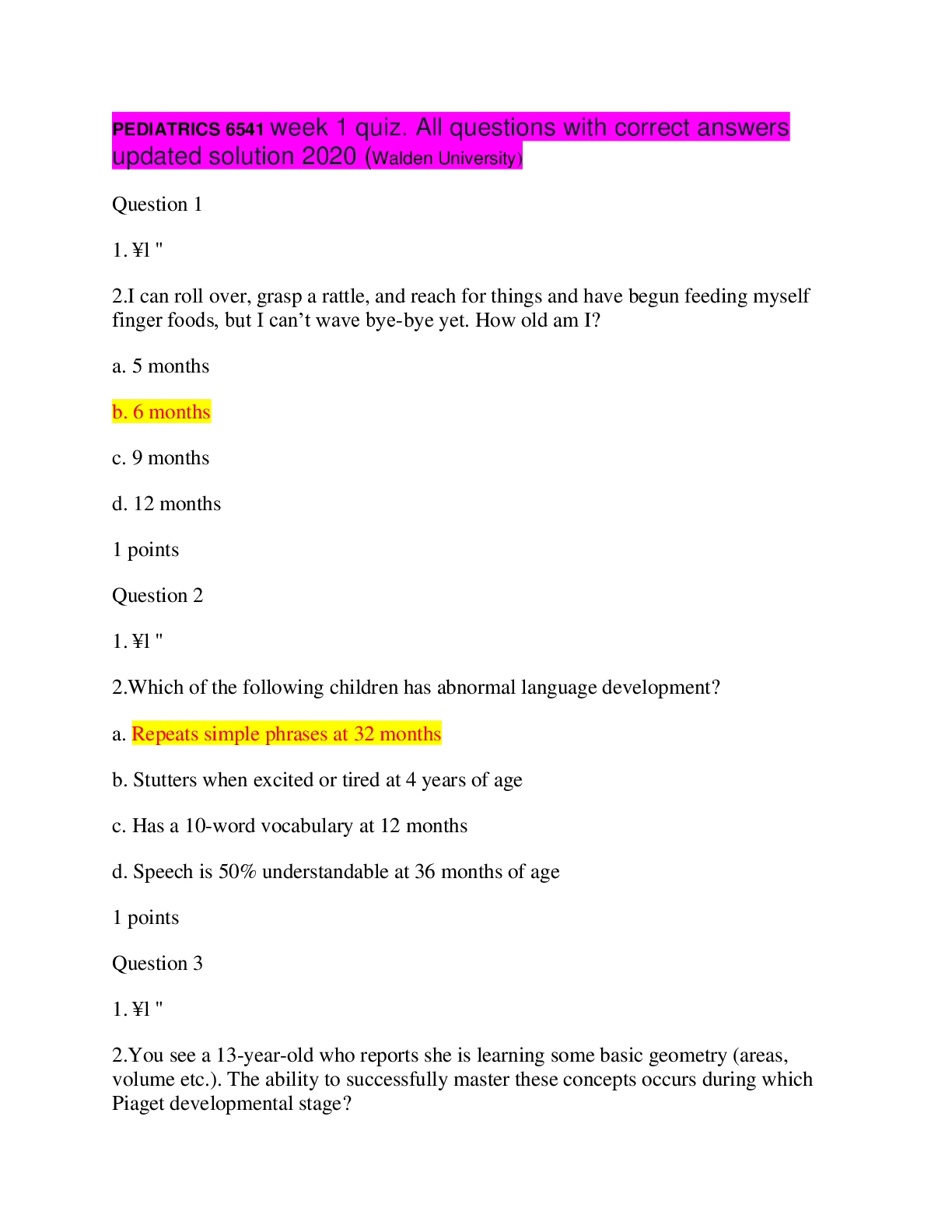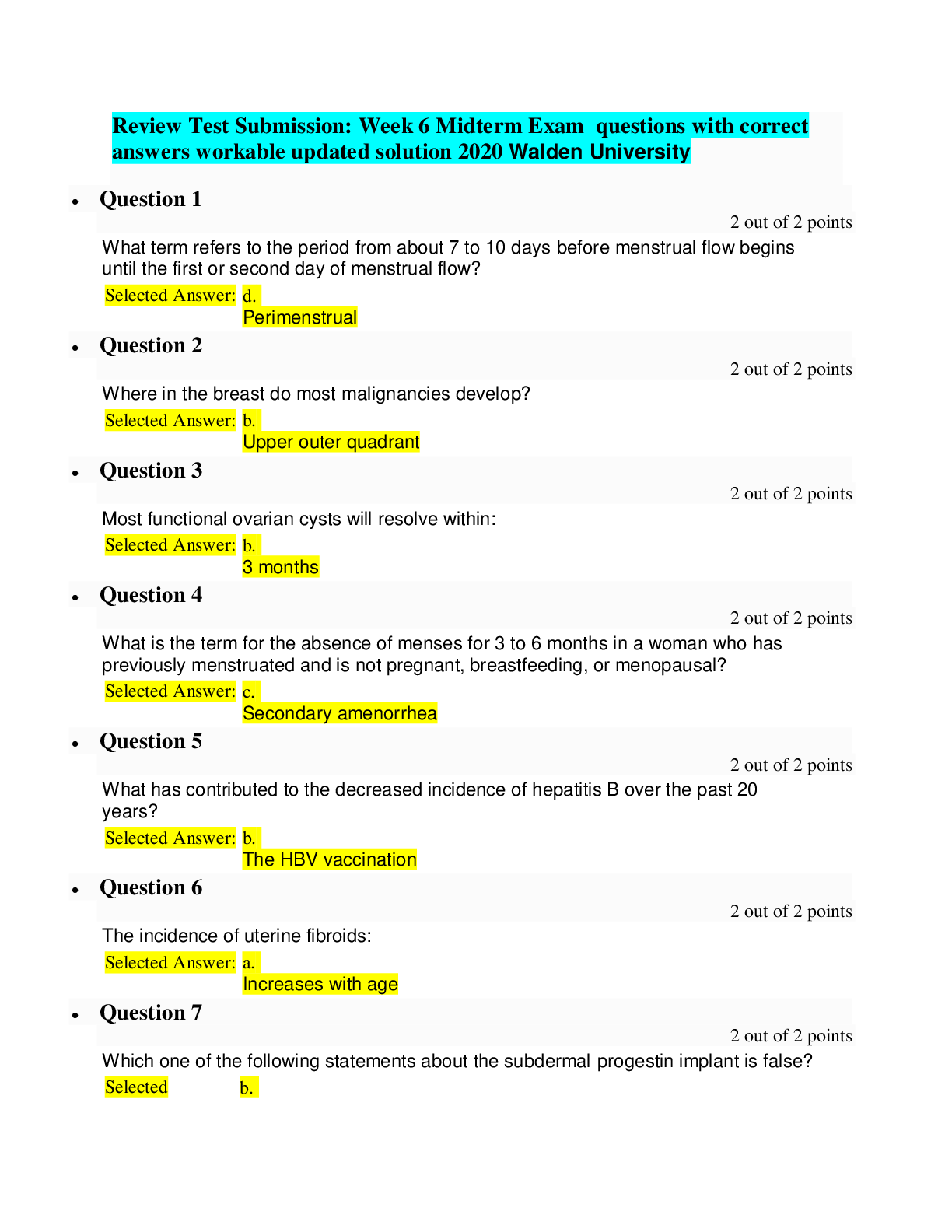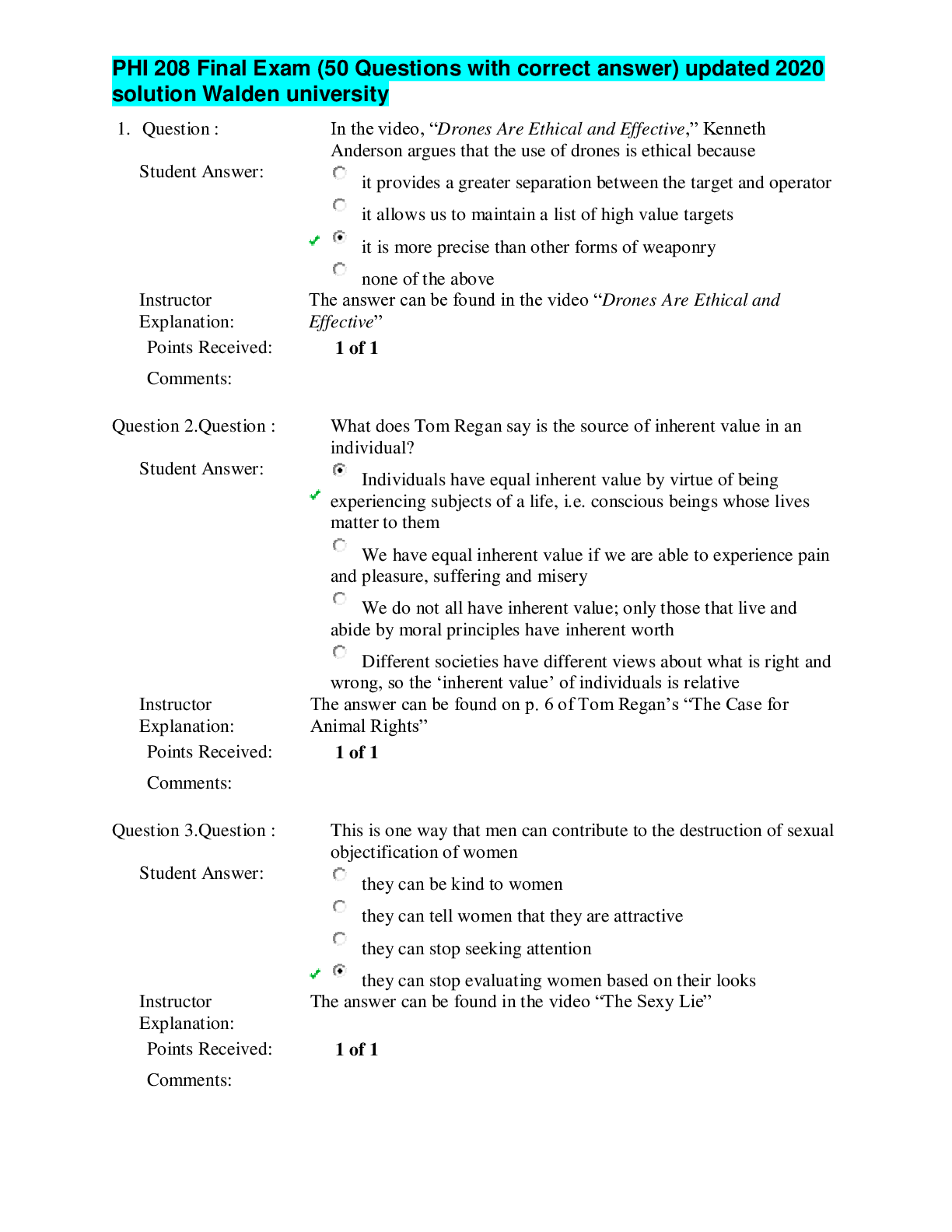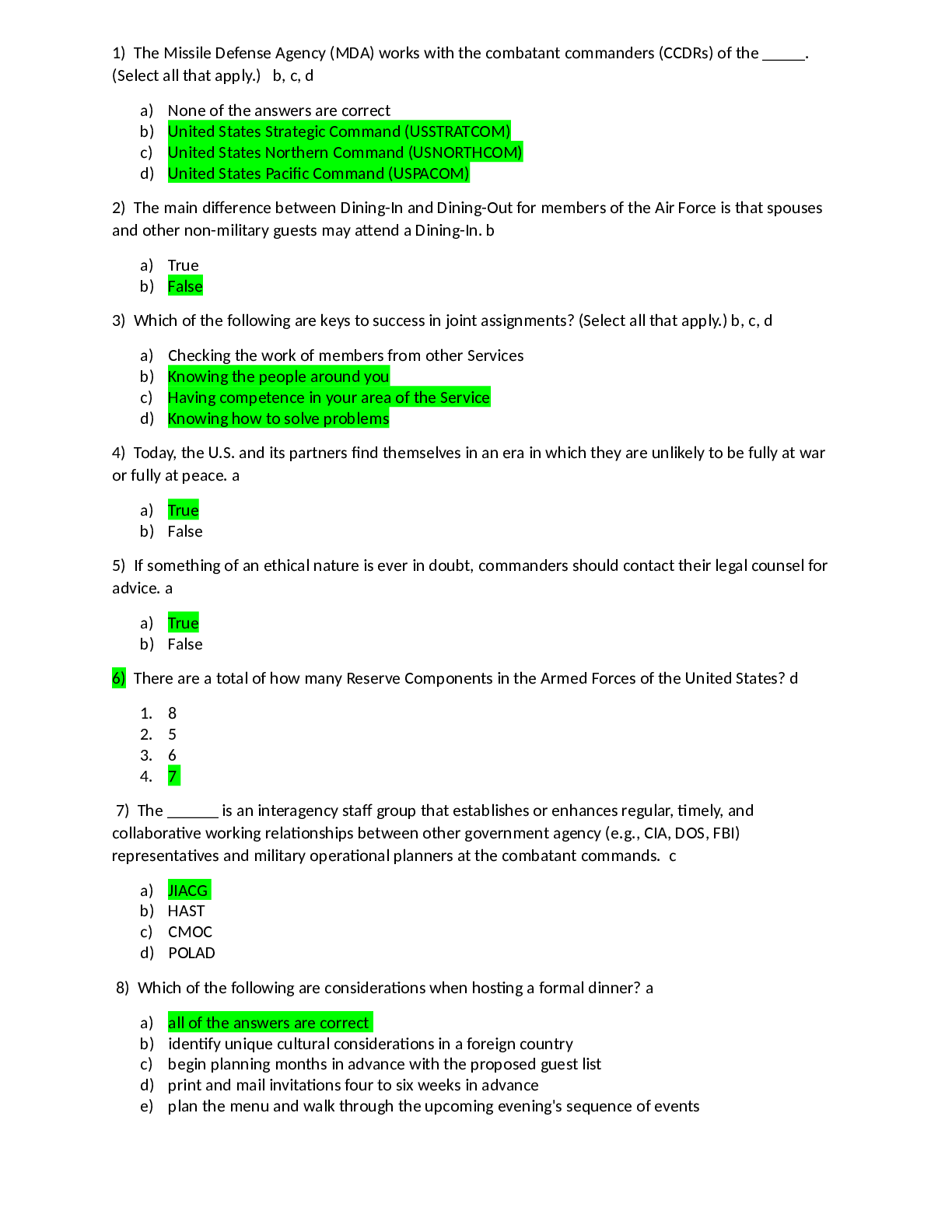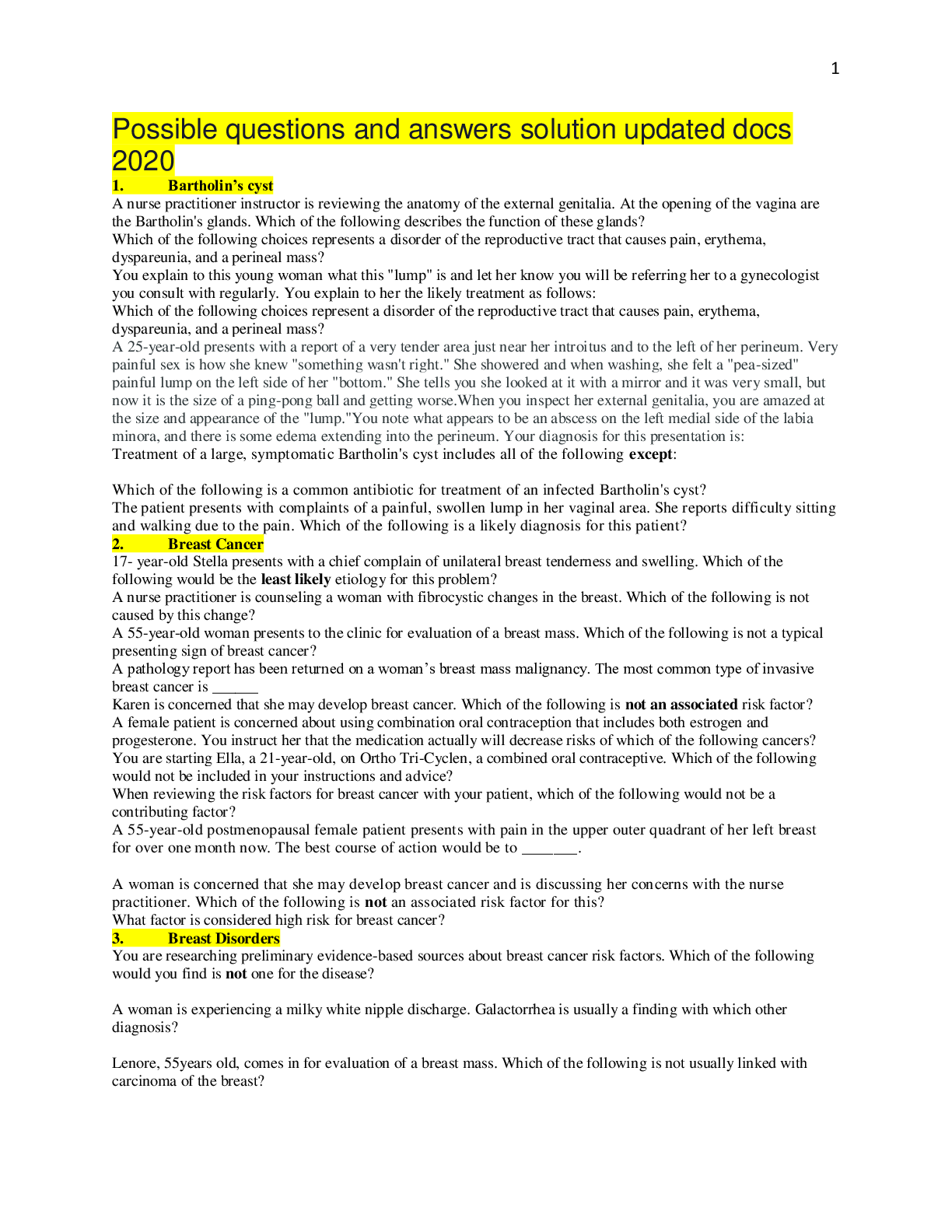*NURSING > QUESTIONS & ANSWERS > 150 ILE PREP FINAL exam Questions with Correct Answers. 2022/2023. Graded A (All)
150 ILE PREP FINAL exam Questions with Correct Answers. 2022/2023. Graded A
Document Content and Description Below
150 ILE PREP FINAL exam Questions with Correct Answers Which of the following statements is most true about the use of gloves? a. Gloves are considered one-time use and should be disposed of after ... each use. b. Gloves can be reused as long as they were not contaminated with blood or other bodily fluids. c. Gloves can be cleaned and reused if properly sanitized. d. Gloves can be saved to be used during a different appointment with the same patient. >Answer>A Which of the following complaints warrants an immediate referral to a physician, preferably one who specializes in diseases of the ear? a. History of noise exposure b. Occasional bilateral tinnitus c. Chronic dizziness d. History of taking ototoxic medications >Answer>c You perform tympanometry on your patient/client and obtain a Type B tympanogram with a normal ea canal volume. What type of hearing loss would you expect them to have? Circle the two best choices. a. Normal hearing sensitivity b. Conductive hearing loss c. Sensorineural hearing loss d. Mixed hearing loss >Answer>b & d Your client is a 50 yr old male. He has a mild to moderate SNHL Au. He has excellent speech discriminat Au. What would be the biggest influence for him purchasing hearing aids? a. opinion of colleagues b. encouragement of spouse c. self-motivation d. degree of tinnitus >Answer>c Flaring out the end of tubing results in what frequency change? a. increases 2000-5000 Hz b. increases 1000-3000 Hz c. decreases 2000-5000 Hz d. decreases 1000-3000 Hz >Answer>a When obtaining audiometric thresholds 1000 Hz is tested twice because a. Test/retest reliability needs to be established b. It is the most important speech frequencyc. It is the hardest tone to hear d. Both A and B >Answer>a Which of the following is not an advantage for using acrylic earmolds? a. extremely durable b. easily modified in the office c. better seal for profound hearing loss d. more easily inserted >Answer>c When taking an ear impression why might your patient cough? a. It's a normal response to cough when nervous b. It's a normal response to cough when Arnold's Reflex is elicited c. It's a normal response to cough when the Stapedial Reflex is elicited d. Stop, use universal precautions and wear a mask, as the client may be contagious >Answer>b Which process refers to the process in which germs are killed 100%? a. Cleaning b. Disinfecting c. Sterilization d. None of the above >Answer>c Which tool should be utilized when verifying otoblock placement in the ear canal? a. otolight b. otoscope c. visual inspection d. tip of syringe >Answer>b Which of the following dynamic ranges would indicate recruitment? a. 25dB b. 45dB c. 65dB d. 85dB >Answer>a Recruitment is most common in a.Conductive hearing losses b. Central auditory processing disorders c. Sensorineural hearing losses d. Mixed hearing losses >Answer>cA 54-year-old male patient/client with normal hearing through 1KHz followed by a precipitous drop in thresholds would do best with a. Non-occluding earmolds b. Skeleton earmolds with select-a-vent c. ITC instruments d. A compression circuit >Answer>a Impacted cerumen a. Will not interfere with impression taking b. Should be surgically removed c. Will have little effect on audiometric tests d. Should be removed prior to audiometric evaluation >Answer>d Your patient/client has a very soft, flaccid outer ear. Due to the shape of the pinna it is recommended h have a skeleton ear mold made. What earmold material would work best for his ear texture, AND what anatomical sections of the outer ear must be included in the ear impression in order for the skeleton m to be a success? a. Acrylic material; antitragus, concha bowl, triangular fossa b. Silicone material; concha bowl, antitragus, helix c. Acrylic material; antitragus, concha bowl, antihelix d. Silicone material; antitragus, triangular fossa, antihelix >Answer>c Your patient/client is concerned that when their hearing aids are off during the night they will not hear alarm clock in the morning. What are two assistive devices that could help them? a. Alarm clock with bed shaker b. Alarm clock with high frequency alarm signal c. Sound signaler that activates bedside lamp to flash d. Telephone wake-up call >Answer>A & C You are performing a first fit with a BTE and custom earmold with SAV venting. Although you have run your feedback manager they are still getting a lot of feedback. You do not want to them to lose any mo gain in the high frequencies. What should you do? A. Make a new earmold as it must be a poor fit issue B. Tell them that their hearing aid is just going to feedback C. Use vent plugs to reduce the vent size until feedback is reduced D. Fill their vent with glue so that they do not get feedback >Answer>C What type of earmold should you use when fitting a CROS hearing device? A. full shellb. half shell c. free field c. full shell with SAV venting >Answer>c Endolymph can be found in which part of the cochlea? a. scala vestibuli b. scala media c. scala tympani d. all chambers of the cochlea >Answer>b Which size of venting would be most appropriate for a patient client with thresholds from 250-1K Hz between 0 to 25 dB HL? a. IROS b. Small c. Medium d. Pressure Vent >Answer>a Which of the following causes of feedback might you need to send the HA in for repair? a. Tubing is cracked or split b. Earhook is split c. Vent is too large d. Microphone is loose within the BTE case >Answer>d Your client reports difficulty hearing words like sip/tip/ship but can hear words like door/floor/more easier. What type of hearing loss would this indicate? a. hearing loss in the low frequencies b. hearing loss in the mid frequencies c. hearing loss in the high frequencies d. hearing loss cannot be determined from this >Answer>c Narrow band noise is a. Actually a variation of brown noise b. Produced by selective warble pulses c. Considered more effective for pure tone masking d. Considered more effective for speech masking >Answer>c While speech discrimination in a moderate conductive hearing loss is generally excellent, discriminatio a moderate sensorineural loss can best be described as a. Excellent b. Good c. Fair to goodd. Poor >Answer>c Your patient/client has been referred to you by his ENT physician to obtain amplification. He recently experienced a sudden sensorineural hearing loss in his right ear and has 8% WRS in that ear. His left ear has a mild to moderate sensorineural hearing loss from 1-8K Hz, with normal hearing in the low frequencies and has 84% WRS. What type of hearing aid would you recommend for him based on his hearing loss? a. A high power BTE for the right ear with a full shell earmold; no hearing aid for the left ear b. A high power BTE for the right ear with a full shell earmold; an open fit BTE for the left ear c. A CROS open fit hearing d. A BiCROS open fit hearing aid >Answer>d TYMPANOGRAM >Answer>SEE BOOK Inter-octaves should be tested when there is a A. 5-10 dB HL difference between adjoining octaves B. 15-20 dB HL difference between adjoining octaves C. 20-25 dB HL difference between adjoining octaves D. 25-30 dB HL difference between adjoining octaves >Answer>B The purpose of word recognition testing is A. to evaluate a patient's/client's ability to recognize mono-syllabic words from a phonetically balanced list B. to evaluate a patient's/client's ability to recognize mono-syllabic words at a soft presentation level C. to evaluate a patient's/client's most comfortable listening level using spondee words D. to evaluate a patient's/client's ability to recognize mono-syllabic words from a phonetically balanced list at UCL >Answer>A In bone conduction testing, ambient room noise will cause a. High frequency thresholds to appear poorer b. Mid frequency thresholds to appear poorer c. Low frequency thresholds to appear poorer d. All frequency thresholds to appear poorer >Answer>c What is responsible for an individual's sense of motion? a. Semicircular canals b. Basilar membranec. Apical end of the cochlea d. Oval window >Answer>a Your patient/client reports that when they put their telephone up to their hearing aid they get feedbac and can't hear well on the phone. What feature setting would help to alleviate the feedback and help them to hear on a standard telephone? a. Feedback cancellation manager b. Acoustic Phone c. Telecoil d. Telecoil/Mic >Answer>c When conducting which speech test should your patient/client be familiarized with the words? a. SRT b. WRS c. PB-Max d. MCL >Answer>a What level is used to run a frequency response curve for an AGC hearing aid? a. 55dBHL b. 60dBHL c. 55 dB SPL d. 60 dB SPL >Answer>d Your patient/client is having some difficulty removing their ITE from their ear. What tip might you provi them to help them to remove it so that discomfort does not result? a. Slightly twist the hearing aid backward and then remove from ear b. Slightly twist the hearing aid forward and then remove from ear c. Slightly pull the bottom portion out before the top portion and then remove from the ear d. Slightly pull the top portion out before the bottom portion and then remove from ear >Answer>b Which test would evaluate the harmonic distortion of a hearing aid? a. SPLITS b. OSPL 90 c. THD d. AGC >Answer>c Increasing the vent size of a custom hearing aid reduces the a. occlusion effectb. feedback c. compression d. receiver bore size >Answer>a A pure conductive hearing loss will show a. All bone conduction thresholds within normal limits b. All air conduction thresholds are better than bone conduction thresholds c. Some bone conduction thresholds within normal limits d. Both A and B >Answer>a Your patient/client's SRT is at 5 dB for the right ear and 10 dB for the left ear. The PTA for the right ear i at 60 and also at 60 for the left ear. WRS presentation levels were 60 dB for both the right and left ears with appropriate masking and they obtained 100%. What is a possible reason for this discrepancy between SRT and PTA? a. the SRT words are too easy b. they are giving suprathreshold responses to pure tone stimuli c. the WRS words are too easyd. they have a central hearing loss >Answer>b When establishing UCL/LDL for a patient/client it is important that they let you know when the level is a. comfortable, but slightly loud b. loud, but okay c. loud d. uncomfortably loud >Answer>d Your patient/client would like to know approximately how many days their 312 batteries (130 mah) wil last. They are wearing their hearing aids about 16 hours a day. You based their battery drain on the HA spec sheet ( .75 ma). a. 12.3 days b. 10.8 days c. 7.2 days d. 4.6 days >Answer>b Why do we look for a PTA/SRT discrepancy? a. To make sure they are repeating words at threshold levels b. To verify pure tone thresholds and check for malingering or possible misunderstanding of instructions during pure tones c. To determine appropriate level for WRS testing d. None of the above >Answer>b What is the test box measure that evaluates the telecoil function?a. THD b. FOG c. STS d. EIN >Answer>c Your patient/client comes in for her follow up visit and reports she can hear people at a distance, but n those at her table when she's at a restaurant. What is the best action to do? a. Reduce venting b. Reduce overall gain c. Reduce compression d. Increase soft sounds >Answer>c You have just completed a complete audiogram and the results indicate an asymmetric sensorineural hearing loss. Although the hearing loss was not reported as a sudden hearing loss in the last 90 days yo best course of action is a. Fit the worse ear only with amplification b. Fit with a CROS hearing aid c. Refer to the otolaryngologist d. Discuss the test results and plan to retest them in one year >Answer>c Microphone and receivers generate internal circuit noise. This is measured with the Equivalent Input Noise (EIN) test. What level should this measure be lower than? a. 50dB b. 40dB c. 30dB d. 20dB >Answer>c What dB SPL level should FOG be run for the 1996 and 2003 ANSI standards? a. 1996: 50 or 60 dB SPL; 2003: 50 dB SPL b. 1996: 50 or 60 dB SPL; 2003: 60 dB SPL c. 1996:50or60dBSPL;2003:50or60dBSPL d. 1996: 50 dB SPL; 2003: 50 or 60 dB SPL >Answer>a The structure that separates the scala tympani from the scala media is called a. The basilar membrane b. The spiral lamina c. Reissner's membrane d. The epitympanic cavity >Answer>aOtotoxic medications cause a. Damage to the ossicles b. Eustachian tube dysfunction c. Damage to the outer hair cells d. Damage to the stria vascularis >Answer>c What is narrow band noise used for? a. speech masking b. pure tone masking c. bone conduction masking d. free field testing >Answer>b Your client/patient has had their BTE and earmold hearing aid for 9 months. She reports that in the last week it has started squealing and she has to turn the volume down to stop the problem. You check her ear canal and she has no cerumen or debris in the canal. What should you do to stop the squealing? a. Rerun the feedback manager b. Decrease the gain in the high frequencies c. Check the tubing for a crack and retube the earmold d. Decrease the gain of all frequencies so that she doesn't have to turn down the volume >Answer>c Medications used by the mother, illness during pregnancy, and inherited conditions can cause what typ of hearing loss? a. Congressional hearing loss b. Congested hearing loss c. Central hearing loss d. Congenital hearing loss >Answer>d What frequencies are used to calculate HF-Average Full-On Gain? a. 500, 1500, 2000 Hz b. 500, 1000, 2000 Hz c. 1000, 1600, 2500 Hz d. 1000, 2000, 5000 Hz >Answer>c Which method allows you to determine if the hearing aid is meeting manufacturer specifications? a. Ling speech sound test b. Listening check c. Visual inspection d. Test box measures >Answer>d.A traditional telecoil in a hearing aid allows the patient/client to hear a. Over the telephone along with room conversation b. Over the telephone, but excluding room conversation c. Better in noisy listening environments d. Over the telephone on all telephones, including cell phones >Answer>b Your 33 yr old female client has a unilateral conductive hearing loss. She reported that her sister had a stapedectomy procedure done for hearing loss. What is the most likely cause of the conductive component of your client's hearing loss? a. Meniere's b. Otosclerosis c. Otitis media d. Ototoxicity >Answer>b A community building has an induction loop installed. How would your client utilize this technology? a. use FM boots b. use T switch c. request headphones at front desk d. use datalogging to track changes to device >Answer>b The otoblock must be a. Placed at the first bend of the canal b. The same diameter as the aperture c. Square in the canal; not skewed d. Placed using the otoscope >Answer>c Your patient/client is a physician and is a first-time hearing aid user who has a mild to moderate sensorineural hearing loss. He is having trouble hearing his patients and nursing staff, and has to use a stethoscope throughout the day. Which style of hearing aid, if any, would you recommend? a. Fit him with BTE hearing aids with thin tube and an open dome b. Fit him with ITE hearing aids c. Fit him with deep-fit CIC hearing aids d. Tell him that hearing aids cannot be used with a stethoscope >Answer>c Which would be most appropriate for a client with a profound hearing loss? a. BTEs, skeleton mold, acrylic material, short canal, #16 tubing b. BTEs, full shell mold, silicone material, long canal, #13 thick wall tubing c. BTEs, half shell mold, acrylic material, short canal, #13 tubing d. BTEs, thin tube, double dome >Answer>bWhich of the following would affect the hearing instrument fitting due to the anatomical concerns? a. Atresia b. Otosclerosis c. Meniere's d. Anoxia >Answer>a Your client has an MTO switch on their hearing aid. What does the O setting do? a. turns the device on b. turns the device off c. changes the device to omnidirectional d. changes the device to an open fitting >Answer>b What are the reasons for using an otoblock when taking an ear impression? a. To ensure that impression material does not encroach on the tympanic membrane b. It can be used to make minimal canal length impressions c. It can be used as a handle to remove the impression from the ear d. All of the above >Answer>a Belling of a tube does what to the high frequencies? a. minimizes b. enhances c. keeps constant d. decreases sound quality >Answer>b Which quadrant allows for the most head movement and therefore is an unacceptable bracing techniq a. anterior-superior b. superior-posterior c. anterior-inferior d. posterior-inferior >Answer>d Dampers smooth the frequency response for which frequencies? a. 250-500 Hz b. 500-1000 Hz c. 1000-3000 Hz d. 4000-8000 Hz >Answer>c Ear Impression picture >Answer>SEE ILE PREP [Show More]
Last updated: 2 years ago
Preview 1 out of 25 pages

Buy this document to get the full access instantly
Instant Download Access after purchase
Buy NowInstant download
We Accept:

Reviews( 0 )
$10.00
Can't find what you want? Try our AI powered Search
Document information
Connected school, study & course
About the document
Uploaded On
Sep 18, 2022
Number of pages
25
Written in
Seller

Reviews Received
Additional information
This document has been written for:
Uploaded
Sep 18, 2022
Downloads
1
Views
251












